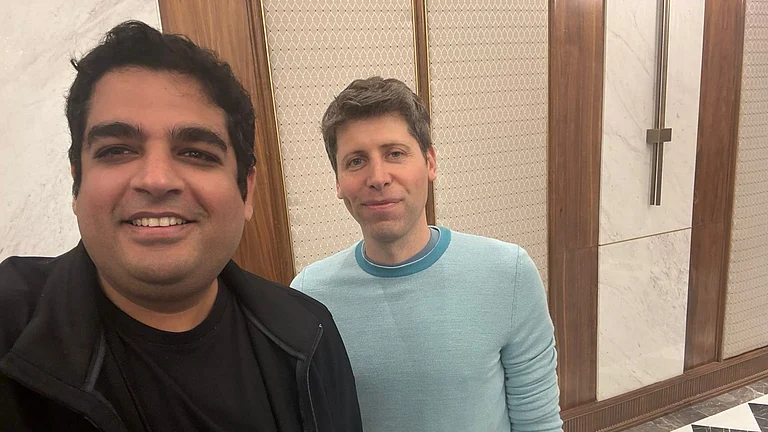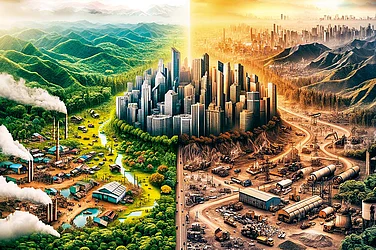Two economists from different ends of India’s political-economic ideology discuss growth and poverty in a post-Covid world. Sanjeev Sanyal, principal economic advisor to the government, and Rathin Roy, managing director at Overseas Development Institute talk to Outlook Business.
The Covid-19 crisis is expected to push more people into poverty in India. What impact will it have on India’s long-term gross domestic product (GDP) growth targets and immediate levels of private consumption?
Sanjeev Sanyal: The Covid-19 pandemic has affected the world economy, including India, and our GDP growth shrank in 2021. But as the economy is opening up, we are seeing a significant revival of growth.
The April-June quarter of 2021 saw a 20.1% year-on-year growth. It will be impacted by a lower base, but we must remember that this quarter was not entirely open as we were going through the second wave.
Except for sectors that have been deliberately kept under some restrictions for health reasons, demand is coming back. Though there are concerns of a possible third wave and supply-side issues like getting chips for the cars and finding containers for exports.
Rathin Roy: India’s long-term gross domestic product (GDP) growth was already jeopardised. Over the past four years, we have been on a steady decline.
What Covid-19 would have done is not so much exacerbate that decline; it is kind of difficult to exacerbate an economy that is already declining. But three things have happened in order of importance—the least important one being the economy shrinking for the first time in the past 30 years. In a growing economy, that’s like losing three years of your life to a debilitating disease. The recovery that India is seeing, to my regret, is one of the slowest in the world.
The United States, very shortly the UK, most European countries and Australia will all have regained their 2019 GDP levels in this calendar year. India will not. People were being boastfully and foolishly optimistic about the Indian GDP recovering in 2021 itself. The GDP of India will not regain the 2019 levels till at least 2022, likely 2023.
The second long-term impact of Covid-19 on India’s economic fortunes has been to point out that basically we are a very fragile economy. To put it another way, the puncturwala economy, the chaiwala economy, which are so dear to the prime minister, is going to recover last and more slowly. While our GDP has fallen, a minority of listed companies are making higher than above profits. That is what’s meant by profit-led recovery. You are producing less and making more money.
Private consumption was already in a mess. As I’ve been arguing, the private consumption of the top 100 and 150 million is what this country was working on. That was only a busted flush. That is why our growth rate was tanking. And we were unable to use this opportunity to change the output composition of demand to tap into the private consumption of the next 250-300 million.
2. Three foreign automakers have quit India in as many years. This, despite the government handing out tax benefits as well as the production-linked incentive (PLI) scheme. Is there something else that the government needs to do for manufacturers?
SS: There are issues related to chip manufacturing that the auto sector is facing but it’s a global problem and has nothing to do with India or its demand. As soon as the global chip supply is restored, car manufacturing will revive.
As far as specific companies are concerned, this is a competitive market. If you want a competitive automobile sector, you should expect uncompetitive companies moving out all the time, just as new ones come in.
RR: Yes. All of us, we cannot just keep blaming the government and need to reflect on why it is that we need to seduce people to invest in India. (Laughs) The majority of India lives in the Gangetic plain, north of the Vindhya. The majority of opportunities should be there.
But it’s a pretty crummy place to do business, I’m told. I certainly would have some sympathy with that view. Though I’m told that the Uttar Pradesh Police is doing a lot of things to make the road safe and prevent caste murders and that the law and order has improved.
I am told that the justice system, too, has improved. I am told that West Bengal also is a peaceful place to do business and that there are no impediments to land, labour and capital. I’m told that is also true for Assam. But if northern and eastern India are becoming wonderful places, then we don’t need to give people incentives to come. The very fact that we’re giving incentives worries me because that means that something is preventing them from considering India to be a good place to do business. I wonder what that is.
3. Some economists called the last decade a ‘lost one’ for India. Does post-Covid India have the policy and fiscal framework to turn the current decade into a decade of opportunity?
SS: We should be very careful to not repeat the mistakes we did during the recovery after the global financial crisis. The government at that time had opened up the banking system and expanded credit indiscriminately without any fiscal restraint.
The banking system today is much healthier than it was in 2015. Even the non-banking financial companies sector is much cleaner. If a situation arises for expanding the financial system, it will be in a position to support growth without misallocating capital.
What we should keep doing is supply-side reforms. Some of the things that will happen now are that we will begin to get the benefits of the Goods and Services Tax, and the Insolvency and Bankruptcy Code. India’s supply side is currently in a very good shape to be able to take advantage of global growth as and when it takes off.
RR: Of course. India can have economic policies and can have the economic framework to reverse an inexorable slide into a decade of cruelly lost opportunities.
4. As the world order changes with new multilateral groupings, do you think India will play a critical role in global supply chains?
SS: Absolutely. We are paying very close attention to these types of changes and the physical infrastructure needed for doing this. But we are also exploring trade agreements with countries that we consider as our allies in this new arrangement.
RR: I would say a country is respected when it’s able to demonstrate that its economy is being able to fulfill expectations in the present tense. That’s it. And therefore, any country, any government would be wisely advised to avoid making grandiose and boastful claims in the future tense.
When we are going to be one of the slowest recovering major economies in the world and when we have the serious internal problems that we are seeing, my professional advice would be to keep very quiet and lie very low. And instead of making grandiose and boastful claims in the future, try and fix things quietly within the economy. To the extent that these can be fixed. Admit errors that were made in the past and try to include more people in one’s vision of where the economy is going.
5. The world over, Covid-19 has led to wealth concentration. Is it the same story in India? Is it a good thing or a bad thing from the perspective of investments and trickle-down theory?
SS: It has some impact to the extent that the rich own more assets which appreciate. It allows them to become richer. However, as economic growth picks up, it will begin to generate jobs and ultimately, economic democratisation will happen.
Secondly, many economists believed that we really should open the monetary and fiscal gates of the economy to reinflate the demand. Instead, we have been much more prudent about it. Our entire approach has been a series of medium-sized packages which are continuously calibrated.
We directed and conserved our fiscal and monetary resources towards the poor. As we rebuild this demand, we are going to orient it towards building physical infrastructure. That is important for two reasons—reinflation will lead to debt building and creation of heavy infrastructure is the best way to create semi-skilled jobs.
In a trickle-down approach, you simply throw in a large amount of resources and inflate the system and then, hopefully, some of it will flow through. Ironically, this has been done in many other countries in the name of the poor. But we have not opted for that.
We have the fiscal space and we intend to use it. But we want to direct it to the poor and towards capital spending, both of which benefit job creation and provide a safety net.
RR: If I can make more money by producing less, I would be a fool to invest. Some companies have made more money while the economy has shrunk. Meaning, we have less output and we have made more money. The answer is simple.
If I were an entrepreneur, I would be stupid to be producing more when I am making more money by producing less.






























